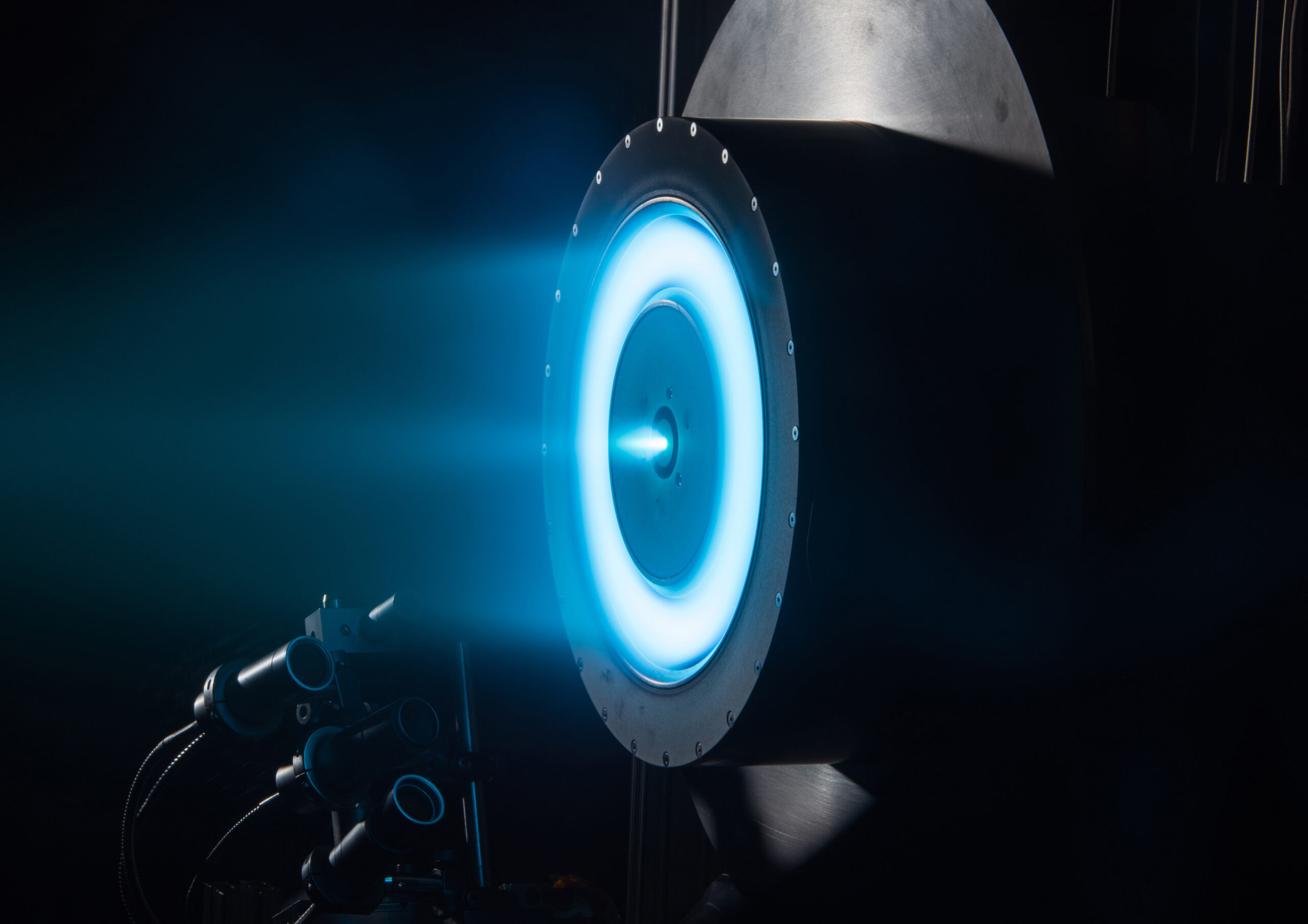Plasma thrusters used on satellites could be much more powerful than previously believed
It has been believed that Hall thrusters, an efficient kind of electric propulsion widely used in orbit, must be large to produce a lot of thrust. Now, a new study from the University of Michigan suggests that smaller Hall thrusters can generate much more thrust—potentially making them candidates for interplanetary missions.
人们一直认为,霍尔推进器是一种广泛应用于轨道的高效电力推进装置,它必须很大才能产生很大的推力。现在,密歇根大学的一项新研究表明,较小的霍尔推进器可以产生更大的推力,这可能使它们成为星际任务的候选者。
ad previously thought that you could only push a certain amount of current through a thruster area, which in turn translates directly into how much force or thrust you can generate per unit area,” said Benjamin Jorns, U-M associate professor of aerospace engineering who led the new Hall thruster study to be presented at the AIAA SciTech Forum in National Harbor, Maryland, today.
“我们以前认为你只能通过推进器区域推动一定数量的电流,这反过来又直接转化为你在单位面积上可以产生多少力量或推力,”本杰明·约恩斯说,他是密歇根大学航空航天工程副教授,他领导了新的霍尔推进器研究,今天在马里兰州国家港举行的AIAA科技论坛上发表。
His team challenged this limit by running a 9 kilowatt Hall thruster up to 45 kilowatts, maintaining roughly 80% of its nominal efficiency. This increased the amount of force generated per unit area by almost a factor of 10.
他的团队通过将9千瓦的霍尔推进器运行到45千瓦,挑战了这一限制,保持了约80%的名义效率。这使得单位面积产生的力几乎增加了10倍。
Whether we call it a plasma thruster or an ion drive, electric propulsion is our best bet for interplanetary travel—but science is at a crossroads. While Hall thrusters are a well-proven technology, an alternative concept, known as a magnetoplasmadynamic thruster, promises to pack much more power into smaller engines. However, they are yet unproven in many ways, including lifetime.
无论我们称之为等离子推进器还是离子驱动,电力推进都是我们星际旅行的最佳选择——但科学正处于十字路口。虽然霍尔推进器是一项经过充分验证的技术,但另一种被称为磁等离子体动力推进器的概念有望在更小的发动机中提供更大的动力。然而,它们在许多方面尚未得到证实,包括一生。
Hall thrusters were believed to be unable to compete because of the way they operate. The propellant, typically a noble gas like xenon, moves through a cylindrical channel where it is accelerated by a powerful electric field. It generates thrust in the forward direction as it departs out the back. But before the propellant can be accelerated, it needs to lose some electrons to give it a positive charge.
霍尔推进器被认为是无法竞争的,因为他们的运作方式。推进剂,通常是像氙这样的稀有气体,通过一个圆柱形通道,在那里它被一个强大的电场加速。当它从后面离开时,向前方向产生推力。但是在推进剂被加速之前,它需要失去一些电子来给它一个正电荷。
Electrons accelerated by a magnetic field to run in a ring around that channel—described as a “buzz saw” by Jorns—knock electrons off the propellant atoms and turn them into positively charged ions. However, calculations suggested that if a Hall thruster tried to drive more propellant through the engine, the electrons whizzing in a ring would get knocked out of the formation, breaking down that “buzz saw” function.
电子在磁场的作用下加速,在通道周围绕圈运行——Jorns将其描述为“电锯”——将电子从推进剂原子上撞击下来,将它们变成带正电的离子。然而,计算表明,如果霍尔推进器试图通过发动机驱动更多的推进剂,在环形内呼啸而过的电子将被击穿,破坏“电锯”的功能。
“It’s like trying to bite off more than you can chew,” Jorns said. “The buzz saw can’t work its way through that much material.”
“这就像试图咬掉你嚼不烂的东西,”Jorns说。“电锯无法穿透那么多材料。”
In addition, the engine would become extremely hot. Jorns’ team put these beliefs to the test.
此外,发动机会变得非常热。Jorns的团队对这些理论进行了测试。
“We named our thruster the H9 MUSCLE because essentially, we took the H9 thruster and made a muscle car out of it by turning it up to ’11’—really up to a hundred, if we’re going by accurate scaling,” said Leanne Su, a doctoral student in aerospace engineering who will present the study.
“我们把我们的推进器命名为H9 MUSCLE,因为从本质上讲,我们把H9推进器调到‘11’级,如果我们按精确比例计算,实际上是达到了100级,”航空航天工程博士生Leanne Su说,她将展示这项研究。
They tackled the heat problem by cooling it with water, which let them see how big a problem the buzz saw breakdown was going to be. Turns out, it wasn’t much trouble. Running with xenon, the conventional propellant, the H9 MUSCLE ran up to 37.5 kilowatts, with an overall efficiency of about 49%, not far off the 62% efficiency at its design power of 9 kilowatts.
他们通过用水冷却来解决热量问题,这让他们看到了人们所认为的分解将是一个多么大的问题。事实证明,这并不太麻烦。在使用传统推进剂氙的情况下,H9 MUSCLE的运行功率高达37.5千瓦,总体效率约为49%,与设计功率为9千瓦时62%的效率相差不远。
Running with krypton, a lighter gas, they maxed out their power supply at 45 kilowatts. At an overall efficiency of 51%, they achieved their maximum thrust of about 1.8 Newtons, on par with the much larger 100-kilowatt-class X3 Hall thruster.
他们使用氪气(一种较轻的气体),最大限度地使用了45千瓦的电力。在整体效率为51%的情况下,他们实现了约1.8牛顿的最大推力,与更大的100千瓦级X3霍尔推进器相当。
“This is kind of a crazy result because typically, krypton performs a lot worse than xenon on Hall thrusters. So it’s very cool and an interesting path forward to see that we can actually improve krypton’s performance relative to xenon by increasing the thruster current density,” Su said.
“这是一个疯狂的结果,因为通常情况下,氪在霍尔推进器上的表现比氙差得多。所以这是非常酷和有趣的前进道路,看到我们实际上可以提高氪的性能相对于氙通过增加推进器电流密度,”苏说。
Nested Hall thrusters like the X3—also developed in part by U-M—have been explored for interplanetary cargo transport, but they are much larger and heavier, making it difficult for them to transport humans. Now, ordinary Hall thrusters are back on the table for crewed journeys.
像X3这样的嵌套式霍尔推进器也由密歇根大学部分开发,已被用于星际货物运输,但它们更大更重,很难运送人类。现在,普通的霍尔推进器又回到了载人飞行的舞台上。
Read more at Phys.org
在Phys.org上阅读更多











